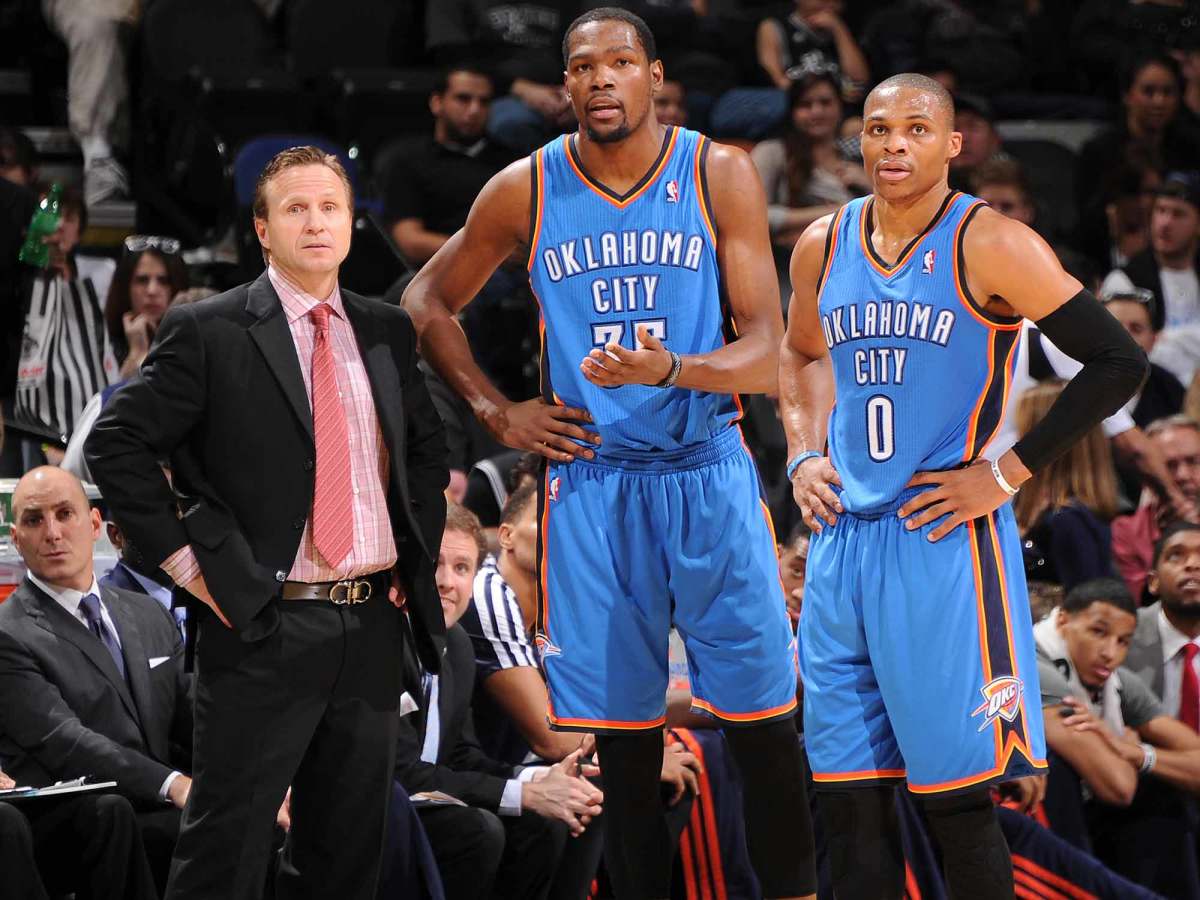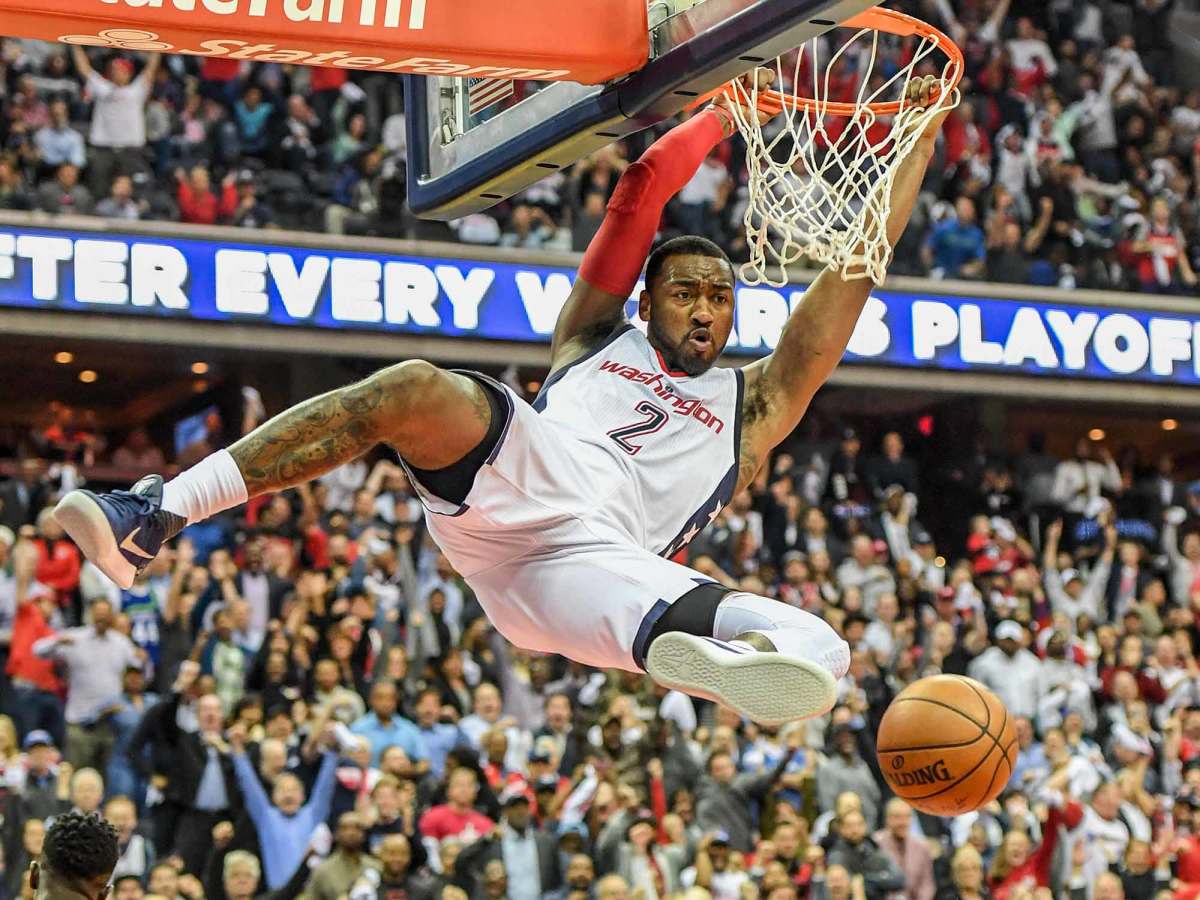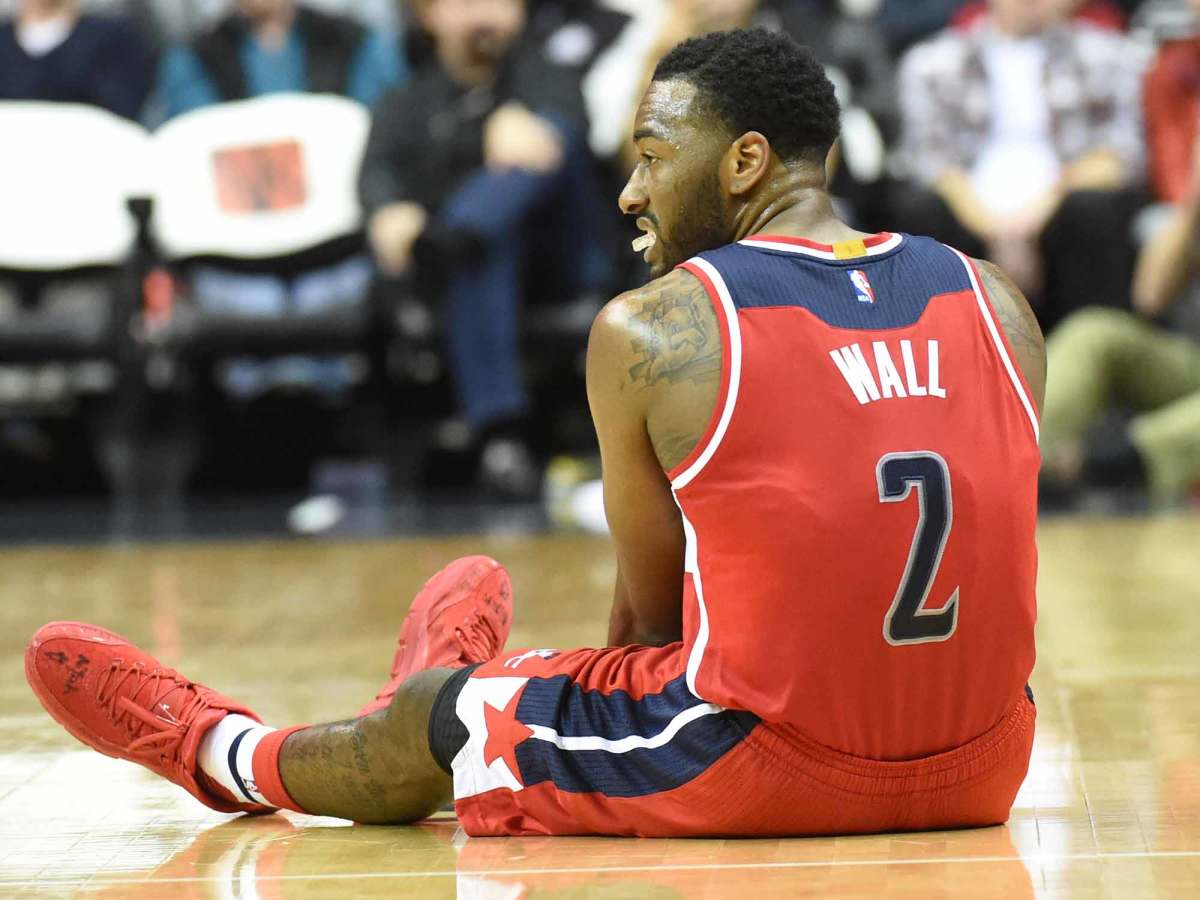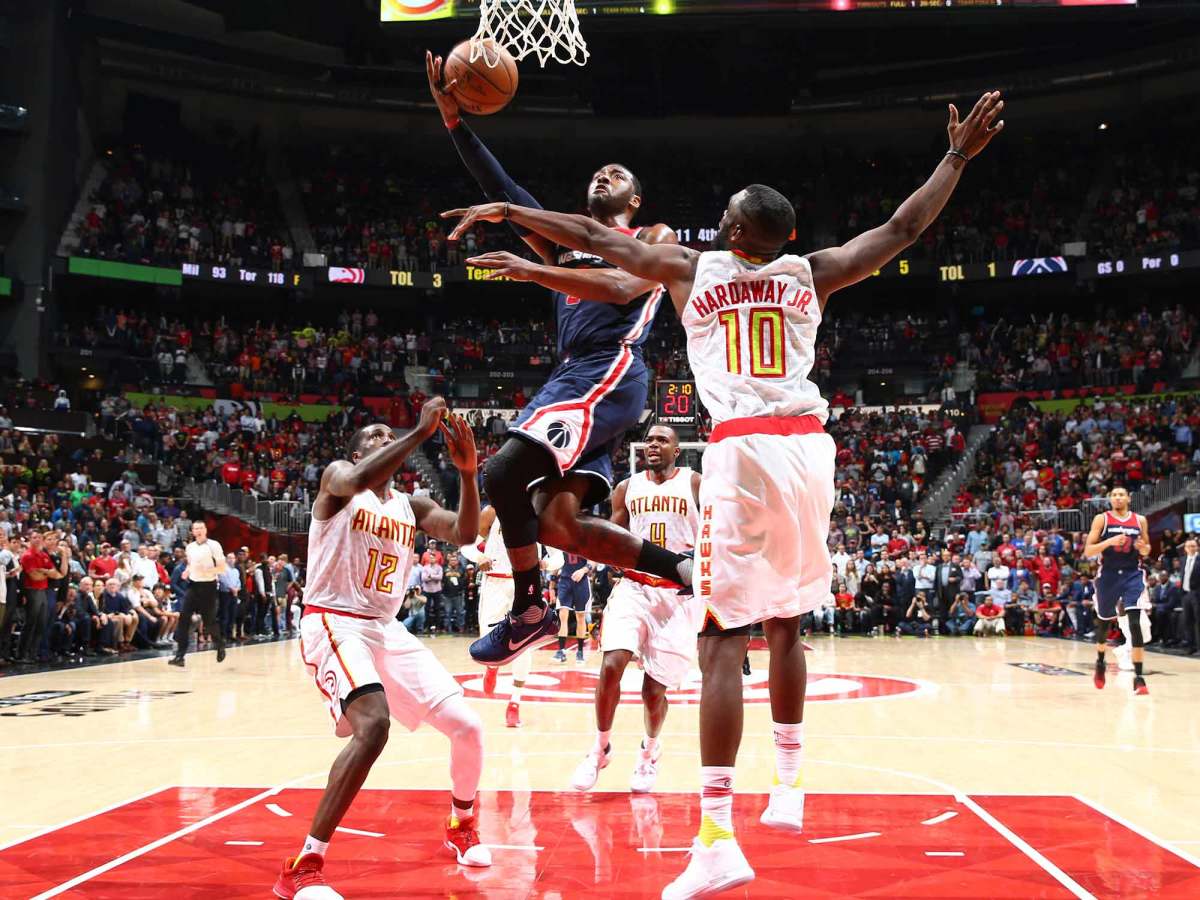The NBA Is Finally Seeing The Real John Wall

Scott Brooks, boss of the Wizards, champion of the point guards, whisperer to Russell Westbrook and John Wall, has been fired twice in his life. The second time was by the Oklahoma City Thunder.
The first time was by his mother.
Lee Brooks raised seven children by herself in the welfare lines of Lathrop—a map dot between Stockton and Modesto in California’s stifling San Joaquin Valley—waiting hours for eggs, cheese and peanut butter. Scott was her youngest, and by the time he turned eight, they were both tired of standing in those interminable lines. Lee took a job at a walnut farm, and on weekends the kids picked from sunrise to sundown at her side. Scott handled the rake. “There are probably 30 rows of walnut trees, and hundreds of trees in each row, and when you’re eight, those rows look like they go on for miles,” he remembers. “You have to shake the walnuts out of the trees, rake them into piles and then put them in a bucket. It’s three buckets to a sack, and at the end of the day you load all the sacks onto a truck and get 50 to 75 cents for each one.”
Scott occasionally shot dirt clods into the bucket, pretending it was a hoop, but most of the time he was a diligent picker. He didn’t complain when temperatures in the Central Valley spiked to 110º, when spiders bit his ankles, when soggy husks left brown-and-green splotches on the only jeans he owned. He ignored classmates who pointed at the stains and whispered that he must be from a walnut-picking family. The trouble did not start until Scott was a sophomore at East Union High and Lee had moved on to a job rebuilding parts at an automotive plant with no air conditioning. She helped him land a janitorial shift at the plant, beginning every day at 2:30 p.m., exactly 12 minutes after school let out. “The plant was four miles away,” Scott recalls, “and I didn’t have a car, so I had to park my bike next to my last class and ride four miles in 12 minutes.” The first time he showed up late on his 10-speed, his mom gave him a warning. The second time, she wrote him up. The third time, she told him not to come back. “Two-thirty-four,” she said, “is not 2:30.”
He did not get fired again until April 2015, at the Casa Del Mar hotel in Santa Monica, by Oklahoma City general manager Sam Presti. Brooks had been the Thunder’s coach since ’08–09, when Westbrook was a manic rookie and Kevin Durant a stick figure, and the fledging team staggered to a 3–29 start. Brooks helped guide Westbrook and Durant to stardom, and the Thunder into contention, amid egregiously timed injuries. In ’14–15, OKC missed the playoffs with 45 wins, often practicing three-on-three because so many players were hurt. As Durant recovered from foot surgery, Brooks unleashed Westbrook, and a triple-double dervish was born. After the season Brooks held 30-minute exit interviews with everybody on the roster before flying home to his family in Newport Beach. Then Presti called. “I made the morning commute, 2 1/2 hours fighting L.A. traffic, to get whacked,” Brooks says. “I was disappointed in how it happened. I knew we had a championship team if we could ever stay healthy, and with all the equity we’d built there, it was hard to hear they didn’t want me back.”

In his year away Brooks hit up five NBA training camps, rocking Spurs gear during a pickup game in San Antonio. He conducted practices for several Orange County high school teams, boys and girls, acclimating himself to speeds a little slower than Westbrook’s. And he thought a lot about his mom, who died of cancer in January 2013, when he didn’t have time to properly mourn. “She used to tell me, ‘There’s always somebody worse off than you,’ ” Brooks says. “And in this league, there are many stories worse than mine.” His childhood prepared him for a career spent alongside coworkers from difficult backgrounds, though not typically farms. Brooks played for six NBA franchises in the 90210 era, and whenever he walked into a new locker room, he sensed what his teammates were thinking: blond hair, blue eyes, from California, went to UC Irvine. Had it easy. He never bothered to correct the inevitable misconceptions, never explained why he couldn’t stand walnuts, but he grew to avoid assumptions himself. “I like to connect with people,” says Brooks, 51. “I like to learn the whole story.”
Last April the Wizards hired Brooks as their coach, well aware of the bond he formed with one jet-fueled, granite-willed, oft-condemned point guard. They bet he could have a similar effect on another. Which is why, one week after his introductory press conference, Brooks flew to Ohio and sat in the cafeteria of the Cleveland Clinic, eating creamed corn with John Wall.
Washington’s best season in 38 years—including the first division title since 1979, the finest individual performance since the Gilbert Arenas age and a 2–1 opening-round lead over the Hawks—started in that cafeteria. Brooks did not want his first conversation with Wall to be at a hospital bed, which is why the coach summoned the star downstairs, even though Wall was recuperating from double knee surgery.
“This is my guy?” Brooks asked himself. “My last guy was, like, really fast.” No one, according to a sampling of NBA players, is faster than Wall. When he was a teenage hellion, fighting and stealing on the streets of Raleigh, his wheels got him out of trouble. “I’d just run,” Wall says, “and hope nobody would say nothin’.” When he was a bored high school junior, whiling away afternoons at Word of God Christian Academy, he joined the track team and promptly won a state championship in the 4x200 relay. After Wall’s nine-month pit stop at Kentucky, the Wizards drafted him with the first pick in 2010, even though he couldn’t shoot and there were questions about whether he could pass. He had the kind of speed, though, that inspires sound effects. “Shoo!” chirps Washington forward Markieff Morris. “If you’re on his team, and you ain’t ahead of that ball, you might as well just hang back and watch.”

Wall raced to the NBA and was immediately instructed to slam on the brakes. The Wizards surrounded him with laughable mentors—Nick Young, JaVale McGee and Andray Blatche, dysfunction in triplicate—but Wall sought guidance outside Washington’s madcap locker room. Westbrook had endorsed one private trainer, Rob McClanaghan, who could oversee his skill work. Durant recommended another, Justin Zormelo, to facilitate his film study and apply analytics. They relayed the same message, underlined every day at practice by Sam Cassell, then a Wizards assistant coach. “Slow down!” Cassell shouted at his jet-packed protégé. “A superhero can’t use his powers all the time.” Wall finished second in turnovers as a rookie (behind Westbrook), leading one-on-three fast breaks and kicking out to teammates who couldn’t keep up. He shot 7.1% from three-point range in his second season and 42.3% overall, off-balance and out-of-control, overrunning ball and rim.
Russell Westbrook's Historic Season Has Come To An End
In the summer of 2012, Wall went to Los Angeles and did drill work at St. Monica High with McClanaghan, learning to drive in slow motion: two dribbles left, change speeds, two dribbles right, change speeds again—then activate turbo boost. As his game decelerated, his vision expanded because he gave himself time to look around. “Passers are usually born more than they’re made,” says one longtime scout. “Wall is different. He turned himself into one of the best passers in the league by seeing the court.” In ’13–14, rid of the Wizards’ many goofballs, Wall made his first All-Star team and playoff run, as Washington beat the Bulls before falling to the Pacers in the second round. It was the best time of his career, and he tried to enjoy it, despite a growing discomfort in his left knee. The irritation would only intensify.
“I’ve been in pain for the past three years,” Wall told Brooks over the creamed corn. During that period Wall was a perennial All-Star. He averaged 18.9 points and 9.7 assists. He sat a total of eight games. He signed a five-year, $80 million extension. He seemed fine. But each day he was quietly going through three hours of treatment for patellar tendinitis in his left knee, lying on a training table after games, practices and midnight flights, two dry needles stuck into the irksome tendon to release muscle tension. A calcification formed, and that bone spur dug into Wall’s knee every time he bent his leg. He had to ride in the backseat of his own car, leg stretched out into the front.
“Three years of misery,” he says. “I couldn’t do extra practice, couldn’t take extra shots, couldn’t improve my craft.” Instead of honing his elbow pull-up, Wall sat attached to a stimulation machine at the Verizon Center called H-Wave, in hope of enhancing blood flow to the knee. For exercise, he ran on an Alter-G anti-gravity treadmill, going so far as to buy an Alter-G for his house. He underwent shockwave therapy and ultrasound-aided treatments, designed to diffuse the calcium deposits, and the agony often subsided. But then the Wizards would play five games in seven nights, or six in nine, and it would return. “You have to take a break,” shooting guard Bradley Beal would tell him. “You have to let yourself heal.” But the last time he had tried that, missing 33 games because of an injury to the same knee in 2012, the Wizards went 5–28 in his absence.
They needed Wall, even if he was a shell of himself. “I know I can jump higher than this, run faster, cut better,” he groused. He watched game film from high school and Kentucky to see how nimble he used to be. Then he showed the clips to Washington trainers, including Thomas Knox, during frequent house calls. “See,” Wall told Knox, “this is me.” When he wasn’t studying his old video, he was monitoring Westbrook and Steph Curry, Kyrie Irving and Damian Lillard, mainstays in the long-running deliberation over the NBA’s best point guards. Wall wasn’t in the conversation. “I’d be about to play a big game against Russ or Steph, and I’m thinking, Damn, I hope my leg is good today,” Wall recalls. “There were so many days I woke up and I was like, ‘I don’t know how the hell I’m going to do this.’ But I couldn’t make an excuse, because I was out there.” Only those closest to Wall could tell that he lacked lift on his jumper, that he strained for every chase-down block and fast-break dunk. He didn’t keep his condition a secret, but he didn’t broadcast it either.

The pain that started in 2013 and escalated in ’14 became unbearable in ’15. That summer, Wall went to the K-Lab at Duke’s School of Medicine for a 3-D biomechanical analysis, after already having flown to St. Louis for a visit with the Cardinals’ team doctor. The Wizards knew the bone spur was growing, but tests did not reveal how much, and they deemed surgery a last resort. In January 2016, Wall left agent Dan Fegan for Rich Paul of Klutch Sports Group, who had been following him for years. “I think you have another level,” said Paul, who is based in Cleveland. “I don’t think you’re right.”
The Golden State Warriors Are Looking Scarier Than Ever
After the season Paul took his new client to the Cleveland Clinic, where Dr. Richard Parker removed a five-millimeter bone spur from Wall’s left knee, in addition to performing a more standard arthroscopic procedure on the right one. Wall keeps a photo of the spur, which resembles a prehistoric saber tooth, on his phone. He shows it off to teammates. That spur, more than Lillard or Irving or a shaky J, is probably why Wall has never made All-NBA or the U.S. national team. It might be why he has gone almost two years without a shoe contract, after Adidas prioritized Lillard and James Harden. Says Wall, “Nobody saw the real John Wall.”
Parker informed Wall after surgery that he was about to play the best basketball of his life, a prognosis Wall relayed to Brooks in the cafeteria. “Well,” the coach thought. “I can’t wait to see this.”
With 10:21 left in the third quarter of Game 1 on April 16, Washington trailed the Hawks by a basket, and the Verizon Center tensed with anxiety accumulated over 38 fallow springs. From his courtside seat Wizards majority owner Ted Leonsis eyed the bench for signs of agitation, but he could not detect any. Then Wall grabbed a rebound, rushed end to end, spun like a cyclone at the free throw line and found Otto Porter Jr. on the left wing for a three; careened down the right sideline and threw in a layup, slamming into Taurean Prince first and the basket stanchion second; put a hellacious crossover on Kent Bazemore, followed by a reverse layup under Dwight Howard’s Jurassic wingspan, and another double cross on Baze, punctuated by a long J; and threaded two lobs, drilled two treys, bullied Dennis Schröder into the post for a layup and embarked on one more furious dash, drawing a trio of defenders to the key before leaving a gimme for Morris. Wall created that whole rollicking mixtape in a span of 8 1⁄2 minutes, scoring or assisting on 24 points, turning a two-point deficit into a 13-point lead—and the District’s unease into euphoria. Even the distinguished owner in the blue-and-red bow tie wagged his foam finger.
Seven years have passed since Leonsis bought the Wizards, since Arenas brandished guns in the locker room and since Wall entered as a one-man disaster-relief unit. “There’s a reason we were able to draft you,” Leonsis told him when they met outside the practice court in June 2010. “We’re not a very good team. This is going to be hard, and at times you’re going to be mad, but it’s yours. Stick with it. You have the fortitude in you.” Wall was raised by his mother, Frances Pulley, who married his father in jail after meeting him between sentences for second-degree murder and robbery with a dangerous weapon. They visited John Sr. in prison almost every Sunday until he was released with a terminal illness. Wall, who was nine when his dad died of liver cancer during a family vacation, was not going to be fazed by an NBA rebuild.
Help is coming, Cassell used to tell him, and the cavalry began to arrive in 2012–13 with Beal, then Porter and MarcinGortat, finally Kelly OubreJr. and Morris. Still, the Wizards started this season 2–8. Then, at an otherwise forgettable late-fall practice, Wall went up to catch a lob and dunked it backward. “Hmm,” he thought. “That was different.” Parker was right. So began a five-month track meet in which Wall became the first player ever to average at least 20 points, 10 assists, four rebounds, two steals and .5 blocks. Wall is a passable three-point shooter, at 32.7%, but he will never incinerate nets like Curry or Irving. Nor does he have to. Now 26, Wall calls himself old-fashioned, a throwback point guard who can reach the rim without the threat of the three. “He’s such a blur, he still gets wherever he wants,” says Clippers guard Jamal Crawford. “Even if you play off him, he finds a gap, and he’s gone.”

For Wall, the midrange is far enough, and he shoots a respectable 38.8% from 16 to 22 feet. “That’s his shot, and if he’s hitting it, you have to go over the screen against him,” adds J.J. Redick, Crawford’s teammate. “Then he’s got a step on you, and it’s over.” The drive-and-kick is Wall’s first option. The drive-and-finish is second. The pull-up ranks a distant third. In Washington’s 1–5 pick-and-roll, Wall often winds up isolated against centers, providing preposterous mismatches. “I remember facing that when I was on other teams and coaches would tell you, ‘Just stay in front! Just stay between him and the basket!’ ” says Wizards center Jason Smith. “Easy to say. Hard to do.” Because Wall spends so much time in the paint among 7-footers—while pop-a-shot peers are ensconced safely on the perimeter—he gets flung around like a 6' 4", 195-pound plush doll. Teammates who know his history wince at every floor burn. “I think he gets hit more than anybody in the NBA,” Morris says. “A lot of times I’m like, ‘Damn, that’s a bad fall. I really hope he hops up.’ But he does.”
Wall has flourished under Brooks for some of the same reasons Westbrook did. As a player, Brooks was loyal to coaches like Jim Lynam in Philadelphia and Rudy Tomjanovich in Houston, who made him their cause. “They had a chip on their shoulder for me,” Brooks recalls. “It was like, ‘Oh, you don’t think Scott should be out there? Well, watch this.’” He was the same way with Westbrook. You think he’s a shooting guard? Watch this. And now, with Wall. You don’t think he’s one of the best point guards in the league? Watch this. Wall is averaging 31.0 points and 10.0 assists in the playoffs, plus he provided the highlight of the first round in Game 3, a coast-to-coast sprint in which he covered the court with four dribbles, bypassed five Hawks and shuttled the ball behind his back for a dunk (going from left to right and back to left). Brooks is demanding in practice and film sessions, but come tip-off, he lets his floor generals loose. Under Brooks’s predecessor, Randy Wittman, Wall reflexively looked to the sideline for play calls. Brooks makes him run the team. “I’ve learned how to talk to people,” Wall says. “Some you can yell at. Some you have to baby.” Asked how he tells the difference, Wall replies, “Cuss at everybody once and see how they react.”
Why Russ And OKC Put Their Trust In Sam Presti
In Game 1 against Atlanta, Brooks was more reserved than usual, Wall more animated. “Every play matters!” he howled in a fourth-quarter timeout, up 12. “Every possession matters!” Wall is charmed—or cursed—by a long memory, and he remains haunted by that Indiana series three years ago. “Game 2, we led [by three] in the fourth quarter, lost that lead,” Wall recounts. “Game 4, we led by 17 at half, lost that lead. Game 6, we go up late in the fourth, and David West goes on one of his sprees.” He can provide a detailed scouting report on West, of course, but also college backups and high school recruits. When the Washington Mystics acquired Elena Delle Donne in February, Wall greeted her at the Verizon Center and offered his analysis of the WNBA landscape.
He watches games constantly, on as many as six screens at once in his house, arguing with friends about every subplot. “He should have been captain of the debate team,” Brooks says. They have much in common, raised in poverty by single mothers they adore, but they don’t talk a lot about that. At the Cleveland Clinic, they began quizzing each other on the eternal hoop questions: Down three, 28 seconds to go, foul or not? The subject changes with the day. Best team ever? Best two guard ever? Best backcourt ever? Wall views Isiah Thomas and Joe Dumars as a model for himself and Beal. Fastest player ever? Brooks imagines a 94-foot dash between Wall and Westbrook at All-Star Weekend. Proceeds could go to Bright Beginnings, a day-care center for children of the homeless in D.C., which is opening a second campus in Ward 8 thanks to Wall’s $400,000 donation.
As Brooks envisioned the race, while hanging out at center court after a recent shootaround, he attempted a pass off his elbow to Porter, and the ball trickled away. Brooks glanced over at Wall, chatting on the bench in black sunglasses, his back to the court. “Good,” the coach thought, “he didn’t notice.” A few minutes passed. “Hey,” Wall chirped, “you’ve got to work on that elbow pass.”
He sees everything now, including a path through the Eastern Conference playoff field, which is looking increasingly jumbled. Who, outside of LeBron James, is most qualified to exploit a scattered floor? Wall, unvarnished and assured, is not capable of a diplomatic answer. He always picks himself.
“Some people get their success early,” Wall says. “Some get theirs late. I feel like my time is just beginning.”
